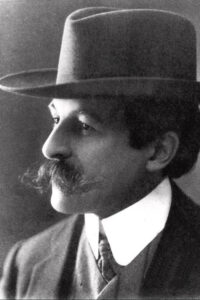
813
A moment later he continued:
“Are you 822.48? I would like to have a word with M. Lenormand, the chief of the detective service. My name’s Kesselbach… Hullo!… Yes, the chief detective knows what it’s about. He has given me leave to ring him up… Oh, he’s not there?… To whom am I speaking?… Detective-sergeant Gourel?… You were there yesterday, were you not, when I called on M. Lenormand? Well, the same thing that I told M. Lenormand yesterday has occurred again today… Someone has entered the suite that I am occupying. And, if you come at once, you may be able to discover some clues… In an hour or two? All right; thanks… You have only to ask for suite 415… Thank you again.”
Rudolf Kesselbach, nicknamed alternatively the King of Diamonds and the Lord of the Cape, possessed a fortune estimated at nearly twenty million sterling. For the past week, he had occupied suite 415, on the fourth floor of the Palace Hotel, consisting of three rooms, of which the two larger, on the right, the sitting room, and the principal bedroom, faced the avenue; while the other, on the left, in which Chapman, the secretary, slept, looked out on the Rue de JudŽe.
Adjoining this bedroom, a suite of five rooms had been reserved for Mrs. Kesselbach, who was to leave Monte Carlo, where she was at present staying, and join her husband the moment she heard from him.
Rudolf Kesselbach walked up and down for a few minutes with a thoughtful air. He was a tall man, with a ruddy complexion, and still young; and his dreamy eyes, which showed pale blue through his gold-rimmed spectacles, gave him an expression of gentleness and shyness that contrasted curiously with the strength of the square forehead and the powerfully-developed jaws.
He went to the window: it was fastened. Besides, how could anyone have entered that way? The private balcony that ran around the flat broke off on the right and was separated on the left by a stone channel from the balconies in the Rue de JudŽe.
He went to his bedroom: which had no communication with the neighboring rooms. He went to his secretary’s bedroom: the door that led into the five rooms reserved for Mrs. Kesselbach was locked and bolted.
Read or download Book
Maurice LeBlanc
Maurice Marie Émile Leblanc (11 December 1864 – 6 November 1941) was a French novelist and writer of short stories, known primarily as the creator of the fictional gentleman thief and detective Arsène Lupin, often described as a French counterpart to Arthur Conan Doyle’s creation Sherlock Holmes.
The first Arsène Lupin story appeared in a series of short stories that was serialized in the magazine Je sais tout, starting in No. 6, dated 15 July 1905. Created at editorial request, Leblanc may have also read Octave Mirbeau’s Les 21 jours d’un neurasthénique (1901), which features a gentleman thief named Arthur Lebeau, and he had seen Mirbeau’s comedy Scrupules (1902), whose main character is a gentleman thief.
By 1907, Leblanc had graduated to writing full-length Lupin novels, and the reviews and sales were so good that Leblanc effectively dedicated the rest of his career to working on the Lupin stories. Like Conan Doyle, who often appeared embarrassed or hindered by the success of Sherlock Holmes and seemed to regard his success in the field of crime fiction as a detraction from his more “respectable” literary ambitions, Leblanc also appeared to have resented Lupin’s success. Several times he tried to create other characters, such as private eye Jim Barnett, but he eventually merged them with Lupin. He continued to pen Lupin tales well into the 1930s.
Leblanc also wrote two notable science fiction novels: Les Trois Yeux (1919), in which a scientist makes televisual contact with three-eyed Venusians, and Le Formidable Evènement (1920), in which an earthquake creates a new landmass between England and France. Leblanc was awarded the Légion d’Honneur for his services to literature and died in Perpignan in 1941. He was buried in the Montparnasse Cemetery. Georgette Leblanc was his sister.
Life
Maurice Leblanc was the second child of Émile Leblanc, a 34-year-old ship-owner merchant, and of Mathilde Blanche (née Brohy) daughter of rich dyers, aged 21 and was delivered by Achille Flaubert, Gustave Flaubert’s brother. He had an elder sister Jehanne (born in 1863) and a younger sister Georgette Leblanc (born in 1869) who from 1883 until the 1920s was an actor and star operatic soprano. During the Franco-German War of 1870, his father sent Maurice to Scotland. Upon his return to France, he completed his studies in Rouen. The young Maurice received his first education in a free institution, the Patry Pension. Then, from 1875 to 1882, completed his secondary studies at the Lycée Corneille. As a teenager, he frequently encountered Gustave Flaubert and Guy de Maupassant.
Refusing the career that his father intended for him at a card factory, Maurice instead headed to Paris in 1888, to pursue writing. First a journalist, then a novelist and storyteller. His first novel, “Une femme” (A Woman), published in 1893 was very successful, and was followed by other works, such as “Des Couples” (The Couples), “Voici des Ailes” (Here Are Wings) and his only play, “La pitié”, released in 1902, which is a failure, causing him to give up the theater for a while. In 1901, he published “L’Enthousiasme”, an autobiographical novel.
In 1905, Pierre Lafitte, the director of the monthly Je sais tout, commissioned a short story from Leblanc, that was to be in the vein of A.J Raffles by Ernest William Hornung and the adventures of Sherlock Holmes. The resulting “L’Arrestation d’Arsène Lupin” (The Arrest of Arsène Lupin) proved to be a great public success. Two years later, the book Arsène Lupin, Gentleman Burglar was released, containing the first nine stories depicting the character that was published in the French magazine ‘Je sais tout’. The following book Arsène Lupin versus Herlock Sholmes, a second collection of Arsène Lupin stories written by Maurice Leblanc, angered the Sherlock Holmes creator Conan Doyle, who saw Leblanc’s Herlock Sholmes and Wilson as parody characters designed to ridicule Doyle’s work.
Maurice Leblanc received the Legion of Honor on January 17, 1908, presented by then Under-Secretary of State for Fine Arts, Étienne Dujardin-Beaumetz. While a supporter of French radical socialists and free-thinker in his early age, Leblanc became more bourgeois around the time of the First World War. Leblanc would start to grow weary of writing Arsène Lupin stories. As early as 1910, he tried to kill his hero in the story “813”, but would resuscitate the character in the story The Crystal Stopper.






